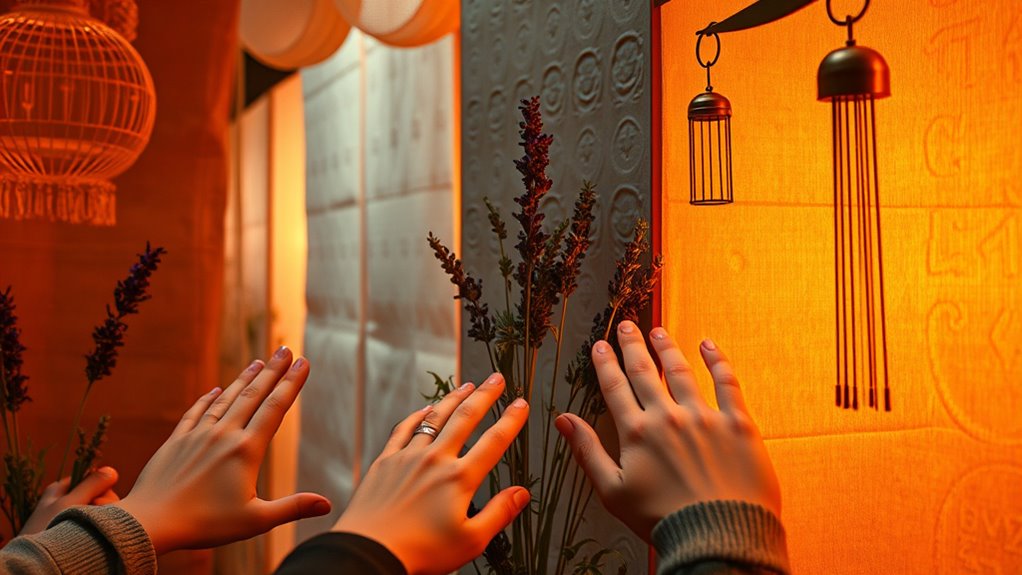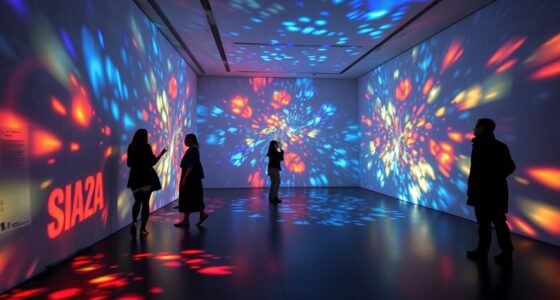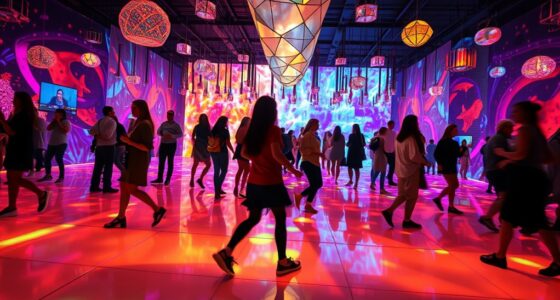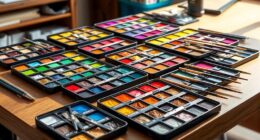Multisensory art combines scent, sound, and touch to create immersive experiences that captivate your senses and evoke emotional responses. It transforms passive observation into active participation by inviting you to explore textures, smell fragrances, and listen to meaningful soundscapes. This dynamic approach enhances memorability and engagement, making art more accessible and memorable. If you continue exploring, you’ll uncover how these elements blend to redefine artistic expression and community connection.
Key Takeaways
- Multisensory art combines scent, sound, and touch to create immersive, memorable artistic experiences that actively engage viewers.
- Incorporating tactile materials and techniques invites physical interaction, enhancing emotional connection and immersion.
- Aromatic elements like essential oils evoke specific moods and memories, deepening emotional responses within the artwork.
- Layered soundscapes and auditory cues reinforce themes, set atmospheres, and guide viewers through sensory storytelling.
- Advances in technology enable personalized, interactive multisensory experiences, transforming passive observation into active participation.
The Evolution of Multisensory Art
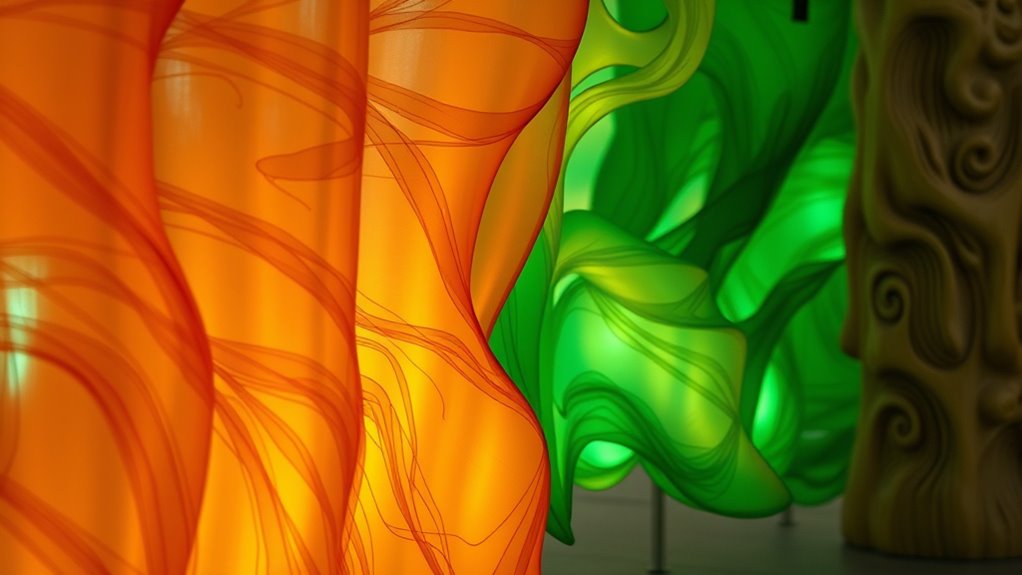
Since its beginnings, multisensory art has continuously evolved, blending different sensory experiences to create more immersive and engaging works. You’ve likely noticed how scent branding enhances an environment, making it memorable and emotionally resonant. Artists now incorporate scents to evoke specific feelings or memories, deepening your connection to the piece. Auditory symbolism also plays a pivotal role, using sound cues and musical motifs to reinforce themes or moods. This blending of scent and sound transforms passive observation into active participation, enriching your experience. Over time, artists have pushed boundaries, integrating these sensory elements seamlessly to craft layered, dynamic works. The evolution reflects a desire to engage your senses fully, making multisensory art a powerful, immersive form that constantly adapts to new technological and artistic innovations. Additionally, the use of high-quality audio and scent delivery technology has significantly enhanced the realism and intensity of multisensory experiences.
Techniques and Materials in Sensory Art
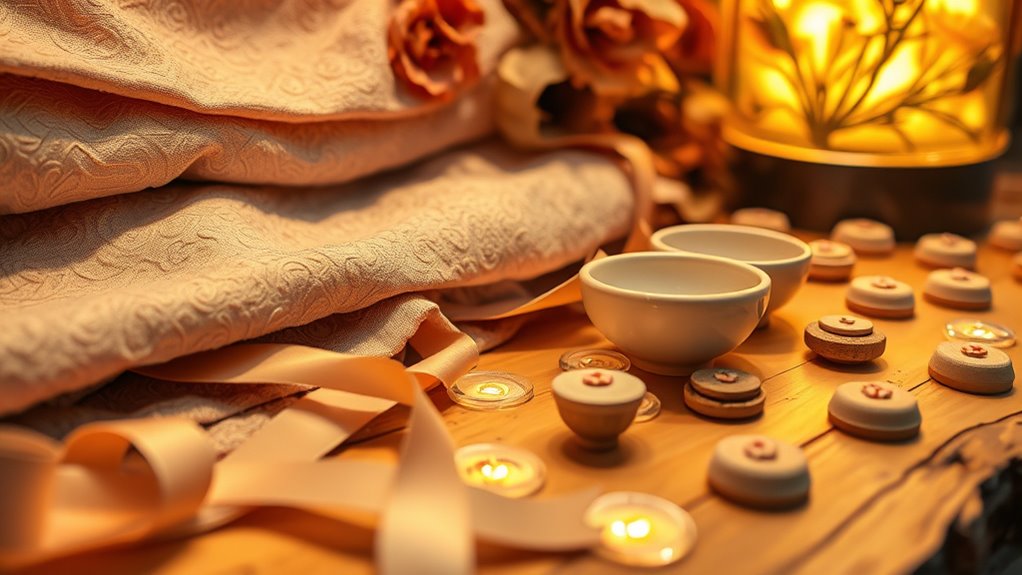
You can explore sensory art through various textures and techniques that engage touch, like layered fabrics or rough surfaces. Incorporating aromatic and auditory elements adds depth, inviting viewers to experience the piece with more than just their eyes. Combining these materials and methods creates immersive artworks that stimulate multiple senses simultaneously. For example, integrating multisensory experiences can significantly enhance viewer engagement and emotional response.
Textural Materials and Techniques
Textural materials and techniques are essential tools in sensory art, allowing you to engage viewers through tactile and visual richness. By manipulating various textural materials, you can create surfaces that invite touch and evoke emotion. Tactile techniques such as layering, carving, or molding enhance the sensory experience, making art more immersive. Experimenting with different textures—rough, smooth, soft, or coarse—helps communicate specific themes or feelings. Use the table below to explore common textural materials and techniques:
| Textural Materials | Tactile Techniques |
|---|---|
| Clay, fabric | Carving, layering |
| Sand, rope | Embossing, pressing |
| Foam, textiles | Molding, attaching |
Additionally, understanding the cost variances associated with different materials and techniques can help artists manage budgets effectively while creating multisensory art. These tools deepen your multisensory approach, making your art resonate on multiple levels.
Aromatic and Auditory Elements
Incorporating aromatic and auditory elements into your art can heighten sensory engagement and deepen emotional impact. Using aromatherapy benefits, you can select scents like lavender or eucalyptus to evoke calm or clarity, enhancing viewer connection. Incorporate natural essential oils into your installations or use scented materials to create immersive environments. For example, firewood preparation techniques can be used to infuse materials with natural scents, adding another layer of sensory experience. Explore sound healing techniques—such as chimes, binaural beats, or calming melodies—to foster relaxation or focus. These sounds can be integrated through speakers or live elements, shaping the atmosphere. Both aromatic and auditory components work together to stimulate the senses, making your artwork more immersive and memorable. By thoughtfully combining these elements, you invite viewers to experience your art on a deeply emotional and multisensory level.
The Role of Scent in Creative Expression
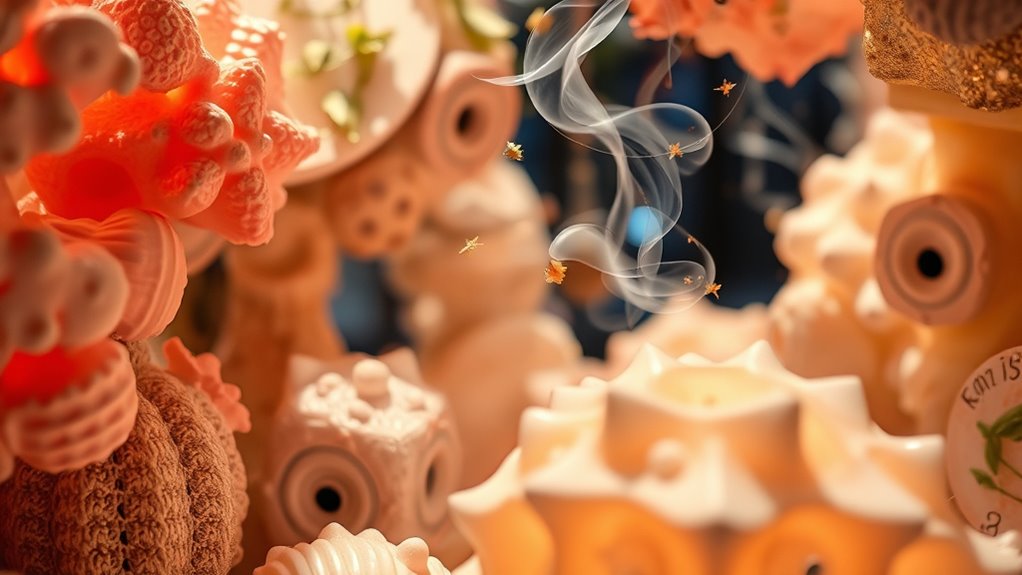
Scent can evoke powerful emotional responses and bring your artwork to life in unexpected ways. By incorporating olfactory memories, you create a deeper connection with your audience. Exploring aromatic composition techniques allows you to craft multisensory experiences that resonate on a personal level. Utilizing best free scent tracking apps can help artists experiment with and refine their olfactory compositions effectively.
Scent and Emotional Response
Have you ever noticed how a particular smell can instantly evoke strong emotions or memories? That’s the power of scent and emotional response. When an aroma triggers memories, it creates a deep emotional connection, enhancing artistic experiences. Artists use scent to evoke feelings, deepen narratives, or set moods. The aroma triggered memories can transport viewers or participants, making art multisensory and immersive. Consider this table:
| Scent | Emotion | Memory Triggered |
|---|---|---|
| Lavender | Calm | Relaxation at home |
| Citrus | Energizing | Morning routines |
| Rose | Romance | Love moments |
| Sandalwood | Serenity | Spiritual practices |
This interplay between scent and emotion allows creators to craft powerful, unforgettable moments, engaging the audience on a visceral level. Additionally, incorporating multisensory elements like scent can enhance the overall impact of artistic expressions.
Olfactory Memories in Art
Olfactory memories hold a powerful sway in art, allowing you to tap into deep-rooted emotions and personal histories. By incorporating scent symbolism, artists evoke specific feelings or memories that resonate on a subconscious level. When you use olfactory cues, you create a visceral connection, making your work more immersive. These memories, anchored in scent, often carry cultural or autobiographical significance, enriching the narrative. You might evoke the scent of rain to inspire renewal or the aroma of a familiar flower to trigger nostalgia. Recognizing the role of olfactory memories helps you craft multisensory experiences that go beyond visual elements. This approach deepens engagement, inviting your audience to explore their own stored associations and emotional landscapes through the power of scent. Additionally, understanding how to organize sensory stimuli effectively can enhance the impact of your art and create more meaningful connections with viewers.
Aromatic Composition Techniques
Artists harness aromatic composition techniques to enhance creative expression, turning scent into a deliberate tool for storytelling and emotional impact. You use scent layering to build complex narratives, blending fragrances to evoke specific moods. Aromatic harmonization guarantees these layers complement each other seamlessly, creating a cohesive sensory experience. Imagine this:
| Top Note | Heart Note | Base Note |
|---|---|---|
| Citrus | Lavender | Sandalwood |
| Fresh Mint | Rose | Amber |
| Green Apple | Jasmine | Musk |
Incorporating Soundscapes for Immersive Experiences
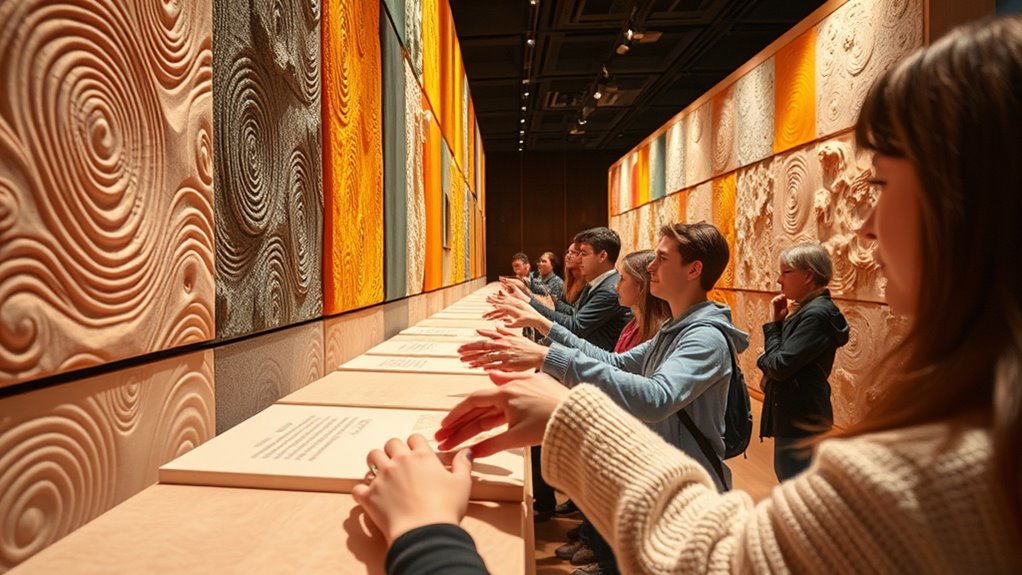
Incorporating soundscapes into multisensory art transforms a viewer’s experience by immersing them fully in the environment. You leverage sound design to craft immersive audio that complements visual and tactile elements, heightening emotional engagement. Thoughtfully curated soundscapes can evoke specific moods, transport viewers to different settings, or even trigger memories. Using layered sounds, ambient noises, and subtle musical cues, you create a rich auditory backdrop that deepens the overall experience. The key is to balance the soundscape so it enhances without overpowering other senses. By integrating immersive audio seamlessly, you guide viewers through a sensory journey that feels natural and enthralling, making the artwork more compelling and memorable. Soundscapes become the heartbeat of multisensory art, enriching the connection between audience and creation.
Tactile Elements and Their Impact on Engagement
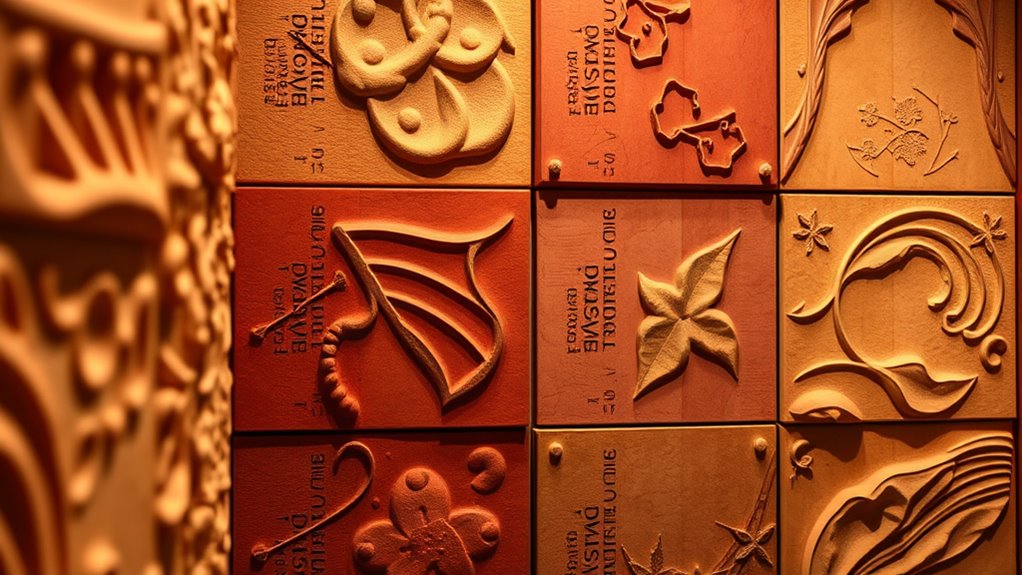
Tactile elements play a crucial role in enhancing engagement by inviting viewers to physically interact with the artwork. When you explore different textures, you deepen your connection and curiosity, fostering a more immersive experience. Texture exploration encourages you to touch varied surfaces, from smooth to rough, adding a sensory layer that words alone can’t convey. Tactile interaction transforms passive observation into active participation, making the art memorable and personal. By incorporating diverse tactile elements, artists stimulate your sense of touch, creating an inviting environment for discovery. This engagement not only heightens your emotional response but also encourages prolonged interaction, as you seek out new textures and sensations within the artwork. Additionally, understanding physical healing and recovery can inform how tactile elements are designed to be safe and accessible for all viewers, ensuring a comfortable exploration of textures. Ultimately, tactile elements serve as a bridge, making multisensory art more compelling and accessible.
Examples of Innovative Multisensory Installations
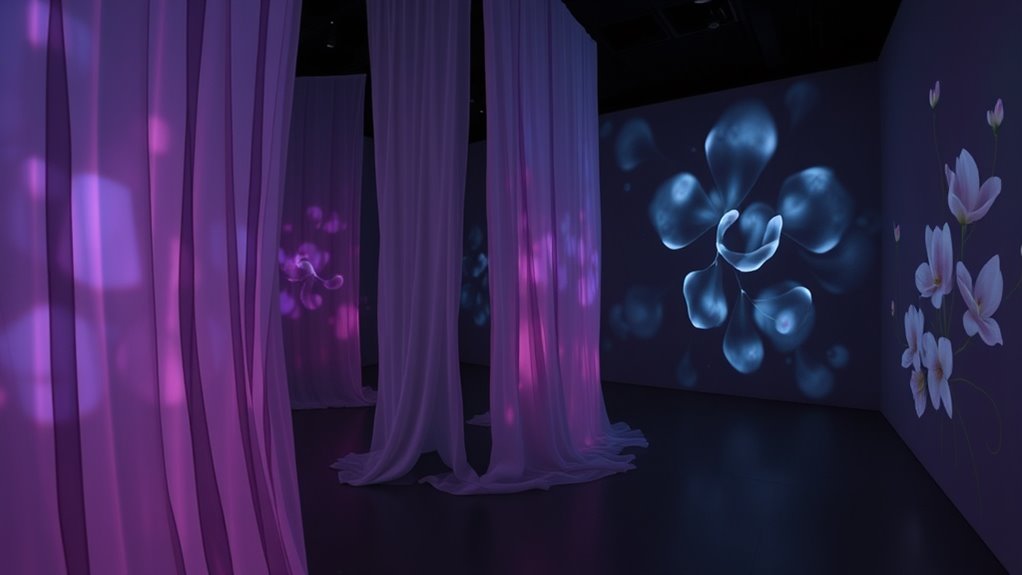
Innovative multisensory installations push the boundaries of traditional art by engaging multiple senses simultaneously, creating immersive experiences that captivate viewers. You might encounter interactive installations that respond to your movements or touch, transforming passive observation into active participation. These setups often employ sensory storytelling, guiding you through narratives enhanced by scent, sound, and tactile elements. For example, some installations use scent diffusers to evoke specific atmospheres, while others incorporate soundscapes that change based on your proximity or gestures. Touch-sensitive surfaces may trigger visual shifts or auditory cues, making the experience deeply personal and engaging. Additionally, incorporating natural materials such as wood, stone, and linen can deepen the sensory connection and authenticity of the experience. These examples showcase how artists blend technology and creativity to craft environments where your senses become an integral part of the story, offering new dimensions of artistic expression.
The Future of Sensory Art in Public Spaces
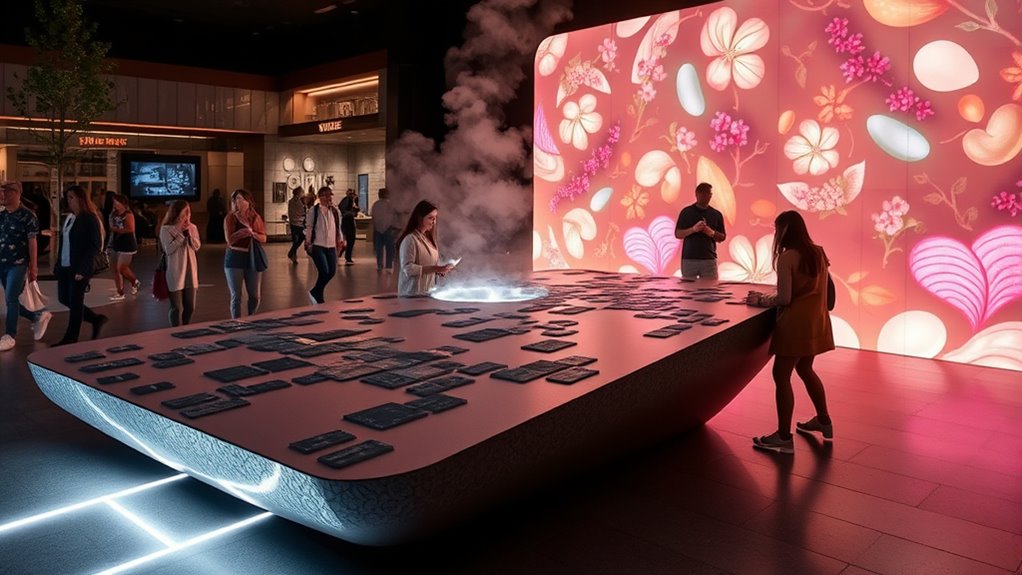
As technology advances, sensory art in public spaces is poised to become more interactive and personalized, transforming how communities experience art daily. Expect to see innovations like:
- Enhanced sensory branding that creates memorable local identities through scent, sound, and touch.
- Multisensory marketing strategies that engage audiences on multiple levels, fostering deeper emotional connections.
- Adaptive installations powered by AI, tailoring sensory stimuli to individual preferences and environmental changes.
- Unleashing creativity by repurposing everyday materials, artists can craft innovative multisensory experiences that resonate uniquely with each community.
These developments will make public art more immersive and accessible, encouraging community participation. The integration of multisensory experiences will elevate traditional sculptures and murals, turning them into dynamic, engaging environments. As a result, public spaces will become vibrant hubs of sensory storytelling, redefining how we connect with art daily.
Frequently Asked Questions
How Do Artists Measure the Emotional Impact of Multisensory Art?
You measure the emotional impact of multisensory art by observing viewer engagement and analyzing emotional responses. You can use surveys, interviews, or real-time feedback to gather insights into how viewers feel and react. Additionally, tracking physiological responses like heart rate or facial expressions offers objective data. Combining qualitative and quantitative methods helps you assess how effectively the artwork evokes emotions and deepens viewer connection.
What Safety Considerations Are Involved in Scent-Based Art Installations?
You should prioritize allergy management and ventilation safety in scent-based art installations. Confirm you select hypoallergenic scents to prevent allergic reactions, and clearly label all fragrances used. Maintain proper ventilation to disperse scents evenly and prevent buildup, reducing respiratory irritation. Regularly monitor air quality, provide alternative viewing options for sensitive visitors, and inform attendees about scent components. These steps keep your installation safe, enjoyable, and accessible for everyone.
How Can Multisensory Art Be Made Accessible to People With Disabilities?
You can make multisensory art accessible by incorporating assistive technology like tactile guides or audio descriptions, ensuring inclusive design caters to diverse needs. Use high-contrast visuals and clear signage for visual impairments, and provide scent-free zones for those with sensitivities. Additionally, consider adjustable levels of sensory input, allowing visitors to customize their experience, making the art engaging and welcoming for everyone.
What Are the Environmental Implications of Using Certain Sensory Materials?
You consider the environmental implications of using certain sensory materials by choosing eco-friendly options, ensuring sustainable sourcing, and reducing waste. Opt for biodegradable scents, natural sounds, and touch materials that minimize harm to ecosystems. By prioritizing sustainable sourcing, you help conserve resources and lower your carbon footprint. This mindful approach promotes an environmentally responsible practice, balancing sensory engagement with the health of our planet.
How Do Cultural Differences Influence Multisensory Art Interpretations?
You’ll find that cultural perceptions shape how you interpret multisensory art, as different societies assign unique sensory symbolism to scents, sounds, and textures. Your background influences what resonates emotionally or symbolically, making your experience deeply personal. Understanding these cultural differences enriches your appreciation, encouraging you to explore diverse artistic expressions. By recognizing these nuances, you can engage more meaningfully with multisensory art across various cultural contexts.
Conclusion
Just as Da Vinci blurred the lines between art and science, multisensory art invites you to explore beyond sight alone. By engaging scent, sound, and touch, you become part of a living, breathing masterpiece. This evolving form transforms spaces into immersive journeys, where your senses lead the way. Embrace this new frontier, and let your experience unfold like a modern Odyssey—rich, surprising, and deeply personal.
